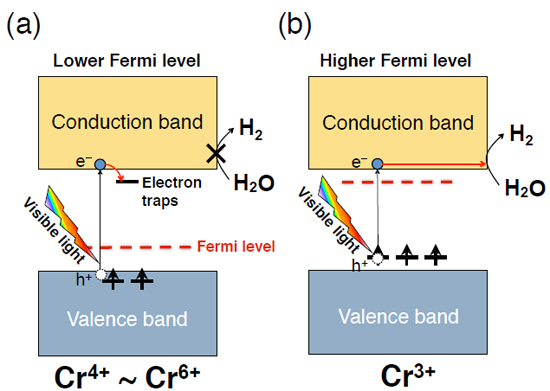Success in Theoretical Design of Photocatalyst Enabling Mass Production of Hydrogen
Expected to Accelerate Technologies for Producing Hydrogen from Water using Solar Light
2013.01.22
(2013.02.06 Update)
National Institute for Materials Science
Japan Science and Technology Agency
A research group headed by Dr. Naoto Umezawa, a Senior Researcher at the NIMS International Center for Materials Nanoarchitectonics (MANA), succeeded in theoretical design of a photocatalyst that enables hydrogen production by water splitting using sunlight.
Abstract
- A research group including Dr. Naoto Umezawa (Senior Researcher), Dr. Jinhua Ye (Unit Director, Environmental Remediation Materials Unit, NIMS), Dr. Pakpoom Reunchan (NIMS Postdoctoral Researcher), Dr. Shuxin Ouyang (NIMS Postdoctoral Researcher), and others of the International Center for Materials Nanoarchitectonics (MANA; Director-General: Masakazu Aono), National Institute for Materials Science (President: Sukekatsu Ushioda) succeeded in theoretical design of a photocatalyst that enables hydrogen production by water splitting under solar irradiation.
- Because the development of photocatalysts had been carried out based on the intuitions of researchers, systematic improvement of photocatalyst activity was difficult. Therefore, construction of design guidelines for promoting development with good visibility has been desired. Researchers around the world have attempted to select promising materials by conducting simulated experiments using computers and realize theory-led development, but few have been successful.
- High expectations have been placed on strontium titanate (SrTiO3) as a photocatalyst. However, this compound cannot absorb visible light, which occupies a large part of the spectrum of sunlight. Therefore, we attempted to expand its visible light absorption by doping with transition metals such as Cr, etc. In recent years, much research has been done on co-doping of transition metal elements and other elements with the aim of stabilizing the oxidation number (valence) of the transition elements, but no clear guidelines exist for selection of the dopant.
- In this research, we studied the optimum combination of dopants based on the electronic structures when Cr and various other elements are co-doped utilizing computational science. As a result, we predicted that the highest activity would occur when La, which has the capacity to form conduction electrons in SrTiO3, is co-doped with Cr. We also confirmed experimentally that this material exhibits high efficiency in evolution of hydrogen from water under visible light irradiation, thus demonstrating the validity of the theory.
- As hydrogen is expected to be an environment-friendly energy source, development of a technology that enables efficient production of hydrogen is awaited. This research demonstrated the effectiveness of theoretical design in the development of photocatalysts, thereby opening a new road toward the development of materials with higher activity. This approach is expected to make an important contribution to solving environmental and energy problems.
- A portion of these research results were obtained as part of the research theme “Development of highly active photocatalysts from ubiquitous elements” (Researcher: Naoto Umezawa) in the Japan Science and Technology Agency (JST) Basic Research Program, Precursory Research for Embryonic Science and Technology (PRESTO), “New Materials Science and Element Strategy” Research Area (Research Supervisor: Prof. Hideo Hosono, Tokyo Institute of Technology). These results were published in the English scientific journal, “Journal of Materials Chemistry A” on the internet on December 21, 2012.
See: http://pubs.rsc.org/en/content/articlelanding/2013/TA/C2TA00450J

Figure : Effect of the position of the Fermi level on the oxidation number of Cr and photocatalytic activity. (a) When the Fermi level is low, activity is reduced because unoccupied orbitals caused by high valence Cr capture photoexcited electrons. (b) The water splitting reaction is accelerated by eliminating unoccupied levels (i.e., stabilizing low oxidation number Cr) by elevating the Fermi level.